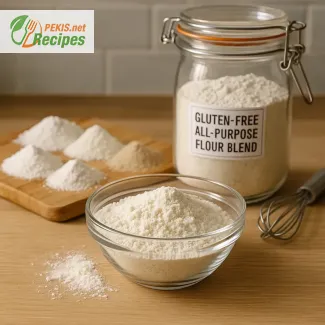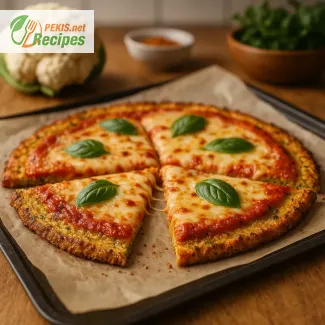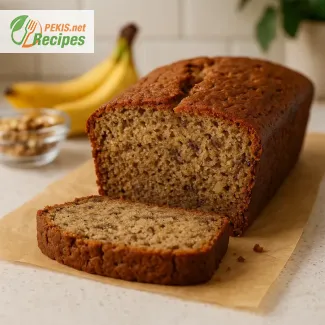
The Perfect Homemade Blend for Gluten-Free Baking Success
Mastering the Art of Custom Gluten-Free Flour Mixes
When it comes to creating mouthwatering baked goods that are free of gluten but full of flavor and texture, nothing is more essential than a reliable gluten-free all-purpose flour blend. Whether you're whipping up fluffy pancakes, golden muffins, rustic loaves of bread, or decadent cookies, the quality of your flour mix can make or break your culinary efforts. While store-bought blends offer convenience, many home bakers are discovering the advantages of preparing their own gluten-free flour blend from scratch. A well-balanced mix not only brings consistency to your baking but also allows you to tailor the texture, flavor, and nutritional value of your recipes.
Crafting your own homemade gluten-free flour blend gives you full control over what goes into your mix. It lets you avoid common additives, starch overloads, and unnecessary gums while fine-tuning the ratio of light, medium, and heavy flours for optimal baking performance. This flexibility is particularly important when addressing dietary needs such as celiac disease, gluten intolerance, or simply choosing a gluten-free lifestyle. Moreover, by customizing your blend, you can adjust moisture retention, elasticity, and structure depending on what you're baking – a soft sponge cake demands a very different texture than a crusty artisan bread.
One of the most important aspects of a successful blend is balance. The best gluten-free flour mix combines a variety of ingredients, each offering specific qualities. Rice flour provides a neutral base and mild flavor, tapioca starch or potato starch introduces chewiness and elasticity, and sorghum flour, millet flour, or quinoa flour bring in subtle nuttiness and wholesome richness. Each component plays a role in mimicking the properties of wheat flour – something that’s notoriously difficult to replicate. But when done right, the results can be astonishingly similar to traditional baked goods in both flavor and texture.
Another benefit of making your own flour mix is the ability to avoid common allergens and refine the flour composition to suit personal sensitivities. Many commercial blends include ingredients like cornstarch, which some people try to avoid, or gums like xanthan gum, which can upset sensitive digestive systems. A homemade gluten-free flour mix without xanthan gum is an increasingly popular alternative. It allows bakers to choose natural binders like psyllium husk, chia seeds, or flaxseed meal to provide structure and elasticity in doughs and batters.
Moreover, the cost-effectiveness of mixing your own flours shouldn’t be overlooked. Buying the base flours in bulk and blending them at home can significantly reduce the cost per recipe, especially for frequent bakers. And once you get used to the process, it's incredibly simple to prepare larger quantities and store the blend in airtight containers, ensuring it’s always ready for your next baking adventure.
Texture is often the biggest challenge in gluten-free baking. Without the natural elasticity of gluten, baked goods can turn out crumbly, dry, or dense. That’s why having a dependable gluten-free flour substitute for all-purpose wheat flour is essential. A well-crafted blend should yield a smooth, uniform texture that allows doughs to bind together and rise properly. It should perform well across a wide range of recipes – from delicate pastries to hearty sandwich loaves – without compromising flavor.
In terms of flavor, the choice of flour components can dramatically change the outcome. While white rice flour keeps things neutral, adding small amounts of amaranth flour or buckwheat flour can introduce deep, earthy notes that elevate rustic baked goods. For lighter treats like sponge cakes or crepes, sticking to superfine rice flour and tapioca starch creates the necessary fluffiness and moisture. This versatility is one of the greatest strengths of a custom blend.
Texture aside, the satisfaction of making a delicious baked item with your own carefully developed flour mix is hard to beat. From the subtle sweetness of millet flour to the binding power of arrowroot, each element contributes something essential. Whether you prefer a more wholesome, fiber-rich mix for breakfast muffins or a silky, starch-forward base for cakes, this adaptable blend offers endless opportunities to explore your own preferences and dietary needs.
The ability to control every ingredient in your gluten-free flour recipe also means fewer surprises when baking. No two commercial blends are the same – some are too gritty, others too gummy. By learning what each flour does and how it behaves under heat, moisture, and fat, you’ll gain the knowledge and confidence to tweak your blend over time and adjust it to seasonal humidity or new baking experiments.
This flexibility also extends to cultural and regional preferences. For example, those looking to recreate traditional European recipes like brioche, strudel, or choux pastry can craft a tailored gluten-free pastry flour mix that focuses on softness and elasticity. Similarly, hearty American-style cookies and dense banana breads benefit from blends enriched with almond flour or teff flour, offering deeper flavor and a softer crumb.
All in all, creating your own gluten-free all-purpose flour blend isn’t just a step toward better baking – it’s a way to take full control over your ingredients, tailor your outcomes, and eliminate the guesswork from gluten-free cooking. Whether you're a seasoned gluten-free baker or just starting out, having a trusted, versatile flour mix on hand can transform your results and bring joy back to every batch of cookies, muffins, and loaves you bake.
- Measure each flour precisely using a kitchen scale for accuracy. This is especially important to maintain the correct texture and baking performance of the final mix.
- Sift all dry ingredients into a large mixing bowl. Begin with white rice flour, followed by potato starch, tapioca starch, and sorghum flour. This helps prevent lumps and ensures even distribution.
- Add xanthan gum to the sifted flours (if using) and stir well with a whisk or spoon to combine all elements evenly.
- Transfer the mixture into an airtight container. Store in a cool, dry place. It will keep fresh for up to 3 months.
- Use as a 1:1 replacement for all-purpose wheat flour in most baking recipes (e.g., cookies, muffins, pancakes). Add appropriate binding agents if needed, depending on the recipe.
Customize Your Perfect Blend: Tips to Elevate Any Gluten-Free Flour Mix
Smart Ingredient Tweaks for Better Texture, Taste, and Versatility
Gluten-free baking has evolved into an art form, and at the heart of every successful bake lies one crucial component: the gluten-free all-purpose flour blend. While many recipes provide a solid base, understanding how to fine-tune this blend to better suit your needs can transform your results. Whether you’re baking chewy cookies, fluffy muffins, or crisp pizza crusts, the ability to adjust ingredients gives you unmatched control over texture, flavor, and nutritional value.
Why make your own gluten-free flour blend?
Creating a homemade gluten-free flour mix not only gives you the ability to avoid preservatives, additives, and unwanted fillers but also opens the door to a more tailored experience. Unlike store-bought blends, which offer a general-purpose solution, a custom mix allows you to adjust ratios depending on your desired outcome. For example, increasing starchy components like tapioca starch results in a lighter texture ideal for cakes, while adding denser grains like sorghum can make your blend better suited for bread.
A homemade mix also allows for better cost control. Bulk ingredients are usually cheaper over time, and you can prepare just the amount you need, ensuring maximum freshness. Plus, if you or your family members have specific dietary needs or sensitivities, making your own blend ensures full control over allergens.
Enhancing texture through strategic flour swaps
One of the biggest challenges in gluten-free baking is recreating the elasticity and structure provided by gluten. Each flour behaves differently, and swapping or increasing certain flours can drastically improve the outcome of specific baked goods. Here are a few examples:
- For more structure and chew (ideal for bread or pizza dough), increase the amount of potato starch or arrowroot flour, which adds stretch and resilience.
- To lighten cakes and pancakes, use more white rice flour or superfine brown rice flour, which creates a fluffier, less gritty result.
- To boost fiber and nutrients, consider swapping a portion of rice flour with teff flour, quinoa flour, or buckwheat flour. These flours also introduce deeper flavors and a pleasant earthiness.
Each substitution affects moisture, rise, and mouthfeel. For example, replacing rice flour with oat flour will add softness but can reduce crispiness in cookies.
The role of binders: adjusting or removing xanthan gum
Most gluten-free flour blends include a binding agent like xanthan gum or guar gum, which helps mimic gluten's ability to hold ingredients together. However, these additives can sometimes cause digestive discomfort and aren’t always necessary.
- Replace xanthan gum with psyllium husk powder, which also helps retain moisture and creates a more pleasant texture in bread and muffins.
- Chia or flaxseed gels (made by soaking ground seeds in water) are excellent natural alternatives that add nutrition and work well in recipes where gum-free blends are desired.
Reducing or removing gums entirely can lead to crumblier textures, so always test small batches first.
Avoiding common mistakes in gluten-free baking
Even with the best blend, success depends on technique. Some of the most frequent mistakes include:
- Not measuring by weight – Many gluten-free flours are more compact or fine than wheat flour. Measuring by volume can result in heavy or dry bakes.
- Using only one type of flour – Relying on a single flour, like just rice flour, leads to gritty or unbalanced texture. Always mix multiple flours with different properties.
- Skipping the sifting – Clumps in starches can result in uneven texture. Always sift your flour mix before use.
- Ignoring hydration time – Letting batter or dough rest for 15–30 minutes allows flours and binders to fully hydrate, improving final texture.
Healthier substitutions and their effects
A well-crafted gluten-free blend can be both delicious and nutritious. To increase health benefits:
- Replace part of the starches (e.g., potato or tapioca) with almond flour or chickpea flour for more protein and healthy fats.
- Add fiber with a portion of oat flour or flaxseed meal – ideal for breakfast muffins or cookies.
- Boost iron and magnesium using flours like amaranth or quinoa, especially for those with restricted diets.
Be mindful that these substitutions can alter taste and structure. Chickpea flour adds a nutty, earthy tone, while almond flour increases moisture but may need additional binders.
How to adapt the blend for specific recipes
Your gluten-free flour mix doesn't have to be one-size-fits-all. Tailor it to your baking goals:
- For cookies: Use a higher ratio of rice flour and tapioca starch for crisp edges and chewy centers.
- For cakes and muffins: Incorporate more starch (potato or arrowroot) and sorghum flour for lightness and tenderness.
- For bread: Increase protein-rich flours like quinoa or teff, and use a stronger binder like psyllium husk.
Experimentation is key. Over time, you'll develop a feel for how your blend behaves in different recipes, making it easier to adapt on the fly.
Batch mix and label your blends
Once you find the perfect balance, make larger batches and label containers with the ratio and intended use (e.g., “Cake Blend” or “Bread Mix”). This small step streamlines your baking process and ensures consistent results every time.
Personalizing your gluten-free flour blend means more than just replacing wheat – it’s about creating a baking experience that suits your needs, your health, and your flavor preferences. With thoughtful tweaks and ingredient knowledge, your traditional flour substitute can become a reliable and rewarding tool in the kitchen.
Allergens present in the recipe:
- Xanthan gum (can cause digestive issues or allergic reactions in sensitive individuals)
How to eliminate allergens and gluten:
- Replace xanthan gum with psyllium husk powder (5 g / 1 tsp), chia seed gel, or ground flaxseed (mixed with water).
- All other ingredients are naturally gluten-free. Ensure they are labeled "certified gluten-free" to avoid cross-contamination.
- Iron: 1.1 mg – supports oxygen transport and energy metabolism
- Magnesium: 20 mg – helps with nerve function and muscle relaxation
- Phosphorus: 56 mg – essential for healthy bones and teeth
- Potassium: 110 mg – maintains normal fluid balance and nerve signals
- Calcium: 10 mg – supports bone density and muscle function
- Zinc: 0.6 mg – boosts immune system and wound healing
- Vitamin B1 (Thiamine): 0.08 mg – supports energy metabolism
- Vitamin B3 (Niacin): 1.4 mg – aids in cholesterol control and energy production
- Phenolic acids (from sorghum flour): 150 mg – reduce inflammation and oxidative stress
- Vitamin E (trace from tapioca): 0.3 mg – protects cell membranes from oxidative damage
- Flavonoids (minor amounts in sorghum and rice flour): 100 mg – support cardiovascular and cellular health





